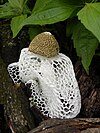Phallus indusiatus, commonly called the bamboo fungus, bamboo pith, long net stinkhorn, crinoline stinkhorn or veiled lady, is a fungus in the family Phallaceae, or stinkhorns. It has a cosmopolitan distribution in tropical areas, and is found in southern Asia, Africa, the Americas, and Australia, where it grows in woodlands and gardens in rich soil and well-rotted woody material. The fruit body of the fungus is characterised by a conical to bell-shaped cap on a stalk and a delicate lacy "skirt", or indusium, that hangs from beneath the cap and reaches nearly to the ground. It was first described scientifically in 1798 by French botanist Étienne Pierre Ventenat. Mature fruit bodies are up to 25 cm (9.8 in) tall with a conical to bell-shaped cap that is 1.5–4 cm (0.6–1.6 in) wide. The edible mushroom, grown commercially and commonly sold in Asian markets, is rich in protein, carbohydrates, and dietary fiber. It also contains various bioactive compounds, and has antioxidant and antimicrobial properties. Phallus indusiatus has a recorded history of use in Chinese medicine extending back to the 7th century AD, and features in Nigerian folklore. (Full article...)
Recently featured: Hurricane Debbie (1961) – Operation Teardrop – Ancient Egyptian deities
